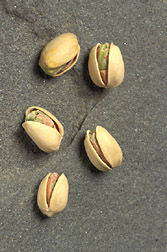This page has been archived and is being provided for reference purposes only. The page is no longer being updated, and therefore, links on the page may be invalid.
|
Unique Pistachio Trees Preserved in California Collection
By Marcia WoodDecember 28, 2004
Pistachio trees from around the world thrive in America's official pistachio collection managed by the Agricultural Research Service (ARS) in Davis, Calif.
This "living botanical library" safeguards more than 750 pistachio trees. For instance, Kerman pistachio trees, which bear the rich, crunchy nuts that make it this country's most popular commercial pistachio, share orchard space with wild, rare and uncultivated relatives.
In all, 10 pistachio species and various hybrids make up this unique collection. Some trees are native to North America; others are from Afghanistan, China, Greece, India, Iran, Israel, Italy, Kazakhstan, Pakistan, Syria, Turkey, Turkmenistan or Tunisia.
Certain pistachio varieties in the orchard bear nuts that are as large as--if not larger than--Kerman pistachios. But these varieties aren't as well suited as Kerman for growing in California, where most of America's 300-million-pound pistachio harvest is produced.
Many kinds of pistachio trees aren't cultivated for their nuts, but instead are used as rootstocks to which the upper, nut-bearing portion of the tree, or scion, is grafted. Or, these species are planted as street trees, especially those like Pistacia chinensis, which has spectacular red and orange foliage in fall.
Besides being fun to eat, pistachio nuts provide fiber, vitamins B1 and B6, thiamin, magnesium, phosphorus and copper, plus smaller amounts of other nutrients.
The California research orchard, formally known as the ARS National Clonal Germplasm Repository for Fruit and Nut Crops, is part of a nationwide network of preserves. ARS, the U.S. Department of Agriculture's chief scientific research agency, operates the network to protect the natural genetic diversity, or gene pool, of crop plants. Plant breeders, researchers and others use these collections to develop new varieties or to discover more about the lineage of existing ones. That's according to Ed W. Stover, ARS research leader and curator at the Davis repository.

